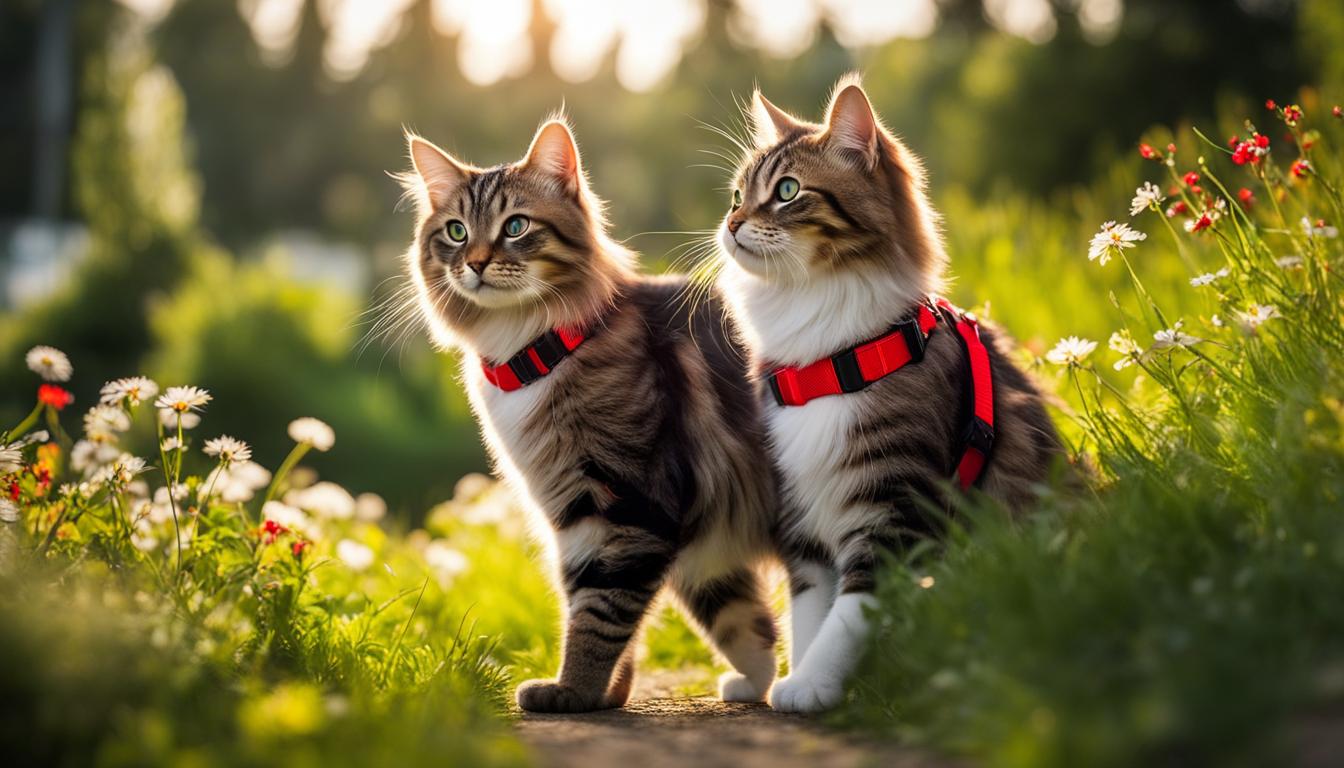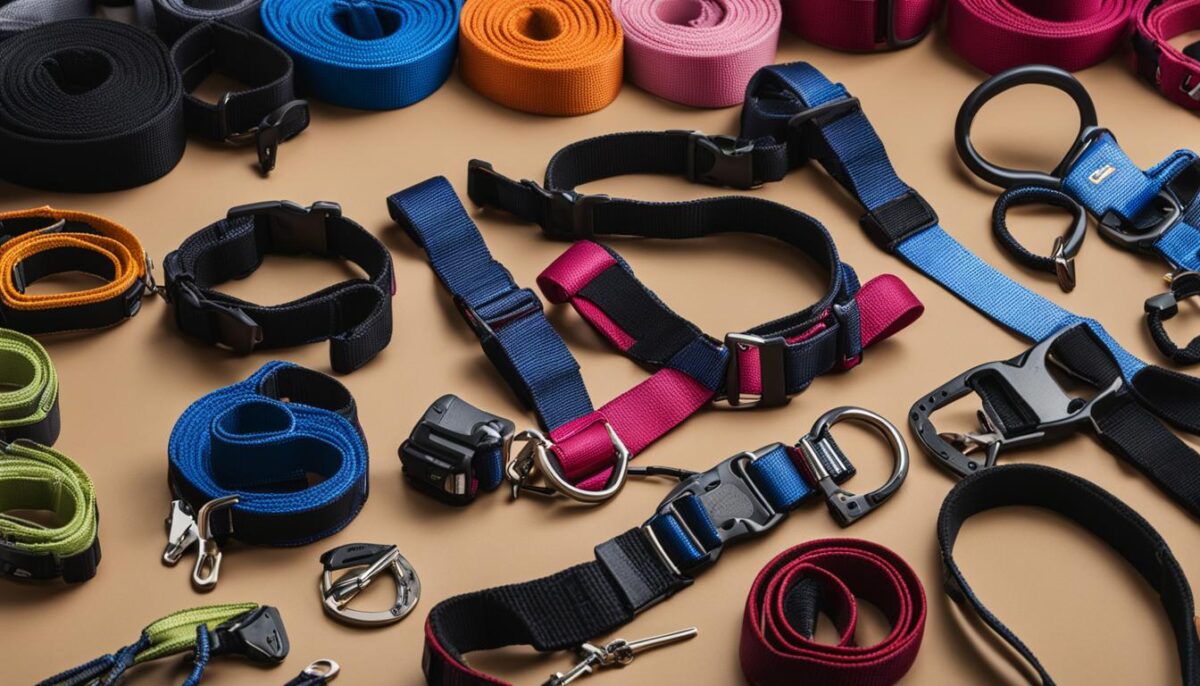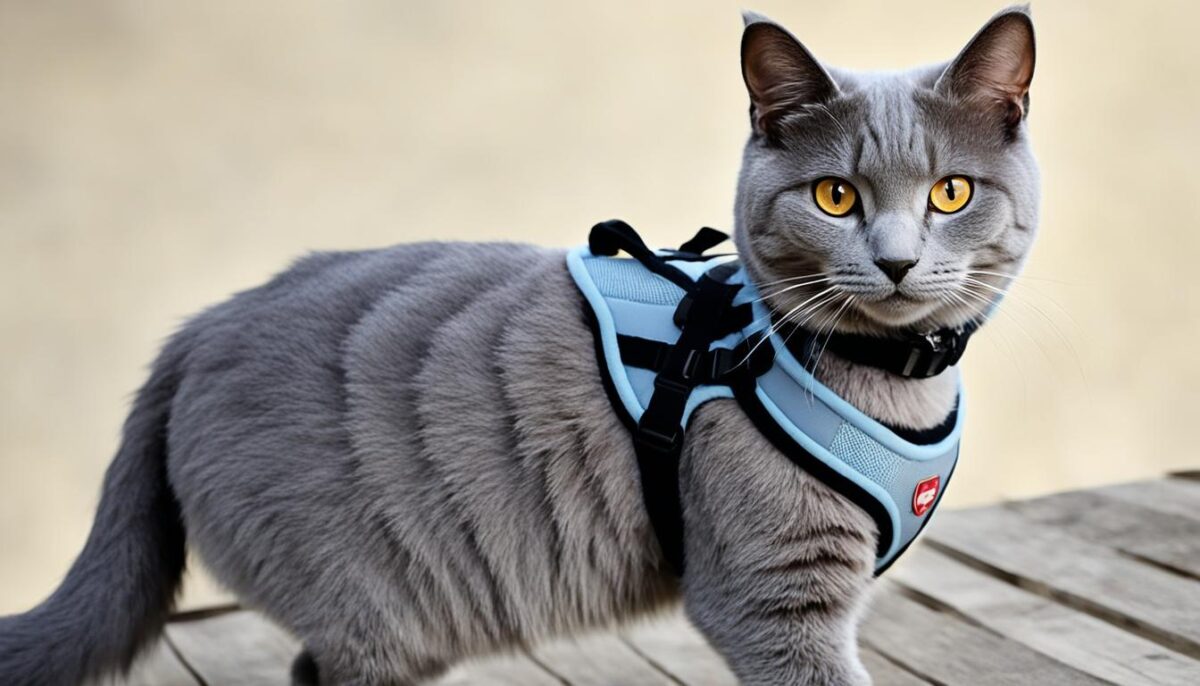Do you want to take your cat on a fun outdoor cat adventure? It’s a great way to play outside together. But before you do, you’ll need to learn about harness training cats. This can help your kitty have fun and be safe. Not all cats like to wear a harness right away. But that’s okay! You can help them learn to like it, step by step.
Cat training takes time. You can start by showing your cat the harness. Let them look at it and sniff it. This helps them get used to it. When they seem okay with it, you can try putting it on them. But remember, the harness has to fit just right. It should not be too tight or too loose. You also need a leash that is not too long. This helps you keep them close and safe.
When you start leash training, pick a good time when your cat is happy and not too playful. And one more thing, never put the leash on their collar. It’s not safe. Use the harness instead. With some love and patience, your cat will be ready to explore with you!
Key Takeaways
- Start harness training when your cat is calm.
- Show the harness to your cat and let them smell it.
- Make sure the harness fits your cat right.
- Use a leash that’s not too long to keep your cat safe.
- Take your time and be patient with your cat.
Understanding the Basics of Cat Harness Training
Before you begin harness training your cat, it’s wise to think about your furry friend’s cat personality. Just like people, cats have their own special ways. Some cats are brave explorers, and others are quiet and like to watch the world go by. By knowing your cat, you can start harness training at the best time for cat training, when your cat feels happy and calm.
Identifying Your Cat’s Personality Traits
Some cats love new things, and others take a little time to get used to changes. Does your cat like to jump and climb everywhere? Or does your cat find a cozy spot and watch everything from there? Patience is very important. Remember, every cat is different and that’s okay!
Choosing the Right Time to Start Training
When choosing the right time to start with the basics of harness training, think about when your cat is most relaxed. It could be right after a nap or maybe when your cat is looking for cuddles. This can often be the best time to introduce something new. Avoid playtime, because your cat might be too excited to learn about the harness.
The Significance of Patience in the Process
Being patient with your cat will make harness training a fun time together. Some cats might need just a few days to feel okay around the harness, while others might need more time. Going slow is the best way to show your cat that the harness is a friend and not something to be scared of. Treats and gentle petting can help too!
| Cat’s Feeling | What To Do |
|---|---|
| Calm and Snuggly | Show the harness, let them sniff it. |
| Curious | Put the harness close, give a treat. |
| Uncertain | Don’t rush; take it off if your cat is unsure. |
Essential Equipment for Successful Harness Training
If you want to teach your kitty to join you for walks, you’ll need some special things. This stuff will help your cat stay safe and comfy. It’s important to choose cat harness equipment that fits just right. A harness that’s too big can slip off, and one that’s too small can be uncomfortable. Let’s find out what gear works best for your furry friend!
A cat walking jacket or a suitable harness for cats is a must-have. What’s a walking jacket? It’s a little like a shirt that your cat wears, and it’s good because it’s comfy and safe. But not all jackets are the same, so make sure it’s the right size for your kitty.
You’ll also need a cat leash – it’s like a long rope that hooks to the harness. At first, you might want a short leash to keep your cat close, and then later, you can try a longer one to let your cat explore more. Remember, a good leash is one that won’t hurt your hands or your cat.
Always use a harness made for cats, not just any old leash. It keeps your cat safe and it’s made to fit your cat’s body without hurting them.
- Fit is key: The harness should snugly fit your cat but still let your cat move easily.
- Safe and secure: The jacket or harness should have strong clips or Velcro to keep it from coming loose.
- Comfy material: Look for soft fabrics that won’t rub your cat’s skin the wrong way.
- Fun colors: Bright colors or patterns can make your cat look cool and make them easier to see.
Now that you know what to get, your cat will be ready for safe and happy walks with you!
Selecting the Perfect Harness for Comfort and Security
When you’re picking out a cat harness, think of it like choosing comfy sneakers for yourself. You want your kitty to feel good and stay safe. First things first, let’s chat about what kinds of harnesses you can get. These are like little outfits just for your cat to wear when you both go on adventures outdoors.
- H-Style Harness: This one has two loops, one for the neck and another for the belly. It looks like the letter “H”. A simple design and usually easy to put on.
- Figure 8 Harness: This harness twists around your cat’s upper body to form an “8” shape. It’s a bit like a magic trick; it loops over and under and keeps your cat cozy.
- Vest Harness: This type is bulkier and covers more. It’s like a little jacket for your cat and might make them feel extra secure.
Each harness snaps closed with buckles or velcro. Try sounding them near your cat before the harness is on. It helps them not be scared. A comfortable harness is snug, but you should still be able to slip a couple of fingers under the straps.
Here’s a tip: try on a few cat harness types to find the one that suits your furry friend perfectly. Every cat is unique, like every person is. Some like a tight hug from their harness, and others want a loose fit.
Now, your job is to make sure your cat is living their best life with a secure cat harness. Happy picking!
Tips for Harness Training Cats
When you start harness training, give your cat some pets and play to make them happy. Then, let them see and sniff the harness. It’s like saying, “Hi!” to a new friend.
Introducing Your Cat to the Harness
Put the harness near your kitty. Let them look at it and get to know it. Give them a treat when they sniff the harness, so they think it’s a good thing. This is how you start cat harness introduction.
Building Positive Associations
Next, let your cat hear the click of the harness and feel it gently without it being tight. While they enjoy a yummy meal, you can softly put the harness by them. It’s like having dessert with a fun toy! You’re building positive associations with the harness.
Gradual Progression to Wearing the Harness
Let’s go slow. First, put the harness on your cat for a very short time. Later, they can wear it while eating or playing. No need to rush with the leash or outdoor time. When they seem okay with the harness, that’s great! You are doing progressive harness training.
Remember: Take it step by step, and give lots of love and treats. This will help your cat like their new harness more and more!
Conclusion
Wrapping up our adventure in cat harness training, we see that taking your cat outside can be super fun! Remember, every cat is one-of-a-kind, but with some cuddles, yummy treats, and time, your furry friend can get to like their harness. Let’s go step by step. Care about how your cat feels, and cheer them on as they grow braver with each practice.
Cats don’t all learn at the same pace, and that’s okay. The most important thing is your kitty’s safety and joy while learning. Keep sharing moments with your cat and stay patient. As you both keep trying, soon you’ll be having great times outside. This is what a successful cat leash walking journey looks like!
So, keep these tips in mind, and you’ll have a neat cat harness training summary to look back on when you and your cat are ready to step out into the big world for some amazing adventures side by side.
FAQ
What are the first steps in harness training cats?
Begin by identifying your cat’s personality traits to tailor your approach. Introduce the harness during a calm time, allowing your cat to explore and sniff it. Build positive associations with the harness using treats and affection.
How do I select the best time to start harness training?
Choose a time when your cat is in a relaxed state, possibly after a meal or when they are calm and receptive. Avoid starting during their high-energy playtime or when they’re agitated.
Why is patience important when harness training my cat?
Cats may take time to adjust to the idea of wearing a harness. Showing patience prevents stress and builds trust, making the training experience more enjoyable and successful for both you and your cat.
What type of equipment is essential for harness training?
A well-fitting cat harness or walking jacket, and a comfortable leash are essential. These ensure safety and comfort for your cat as they learn to walk on a leash.
How do I make sure the harness is comfortable and secure?
Choose a harness that fits snugly without being too tight. There are several types, such as “H-Style”, “Figure 8”, and “Vest Harness”, so you may need to try a few to find the perfect fit for your cat.
Can you provide tips for building positive associations with the harness?
Use treats to reward your cat when introducing the harness and create pleasant experiences linked to harness time. Allow your cat to associate the harness with positive interactions and rewards.
What does gradual progression in harness training involve?
Gradual progression means taking small steps in the training process. Start with your cat wearing the harness for short periods indoors, then slowly increase the time and introduce the leash before eventually moving outdoors.


